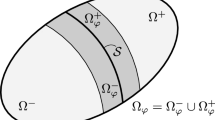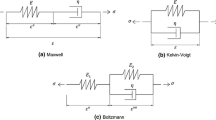Abstract
A drawback of the boundary element method (BEM) to analyse solid non-linear problems is the necessity to discretize, not only the boundaries, but also the domain in internal cells. Such discretization is required to evaluate the domain integrals involving the inelastic (initial) fields and represents a loss of one of the most remarkable features of the BEM, which is the reduction of the problem’s dimension by one order. However, only regions where the dissipative effects take place need to be divided in cells, allowing optimization of the non-linear solution algorithms. In this paper, one of these optimization attempts is present in which the cells are progressively activated, augmenting the corresponding matrices, as the inelastic region develop and grow. In addition, the implicit formulation of the BEM with a unified constitutive modelling framework is used in order that different material behaviours may be addressed by a single numerical structure. Three numerical examples are presented: two involving ductile material behaviour, modelled with the elastoplastic von Mises associative constitutive model, and another to simulate quasi-brittle behaviour by an isotropic damage constitutive model.













Similar content being viewed by others
References
Peixoto RG, Ribeiro GO, Pitangueira RLS, Penna SS (2017) The strong discontinuity approach as a limit case of strain localization in the implicit BEM. Eng Anal with Bound Elem 80:127
Swedlow JL, Cruse TA (1971) Formulation of boundary integral equations for three dimensional elastoplastic flow. J Solids Struct 7:1673
Mendelson A (1973) Boundary integral methods in elasticity and plasticity. Tech. rep., NASA TN D-7418, NASA, USA
Riccardella PC (1973) An implementation of the boundary integral technique for planar problems in elasticity and elastoplasticity. Tech. rep., SM-73-10, Carnegie Mellon University, Pittsburgh, USA
Mukherjee S (1977) Some remarks about the formulation of three-dimensional thermoelastoplastic problems by integral equations. Int J Solids Struct 13:331
Bui HD (1978) Some remarks about the formulation of three-dimensional thermoelastoplastic problems by integral equations. Int J Solids Struct 14:935
Telles JCF, Brebbia CA (1979) On the application of the boundary element method to plasticity. Appl Math Model 3:466
Telles JCF, Carrer JAM (1991) Implicit procedures for the solution of method to plasticity. Math Comput Model 15:303
Lin FB, Yan G, Bažant ZP, Ding F (2002) Non-local strain softening model of quasi-brittle materials using boundary element method. Eng Anal Bound Elem 26:417
Sládek J, Sládek V, Bažant ZP (2003) Non-local boundary integral formulation for softening damage. Int J Numer Methods Eng 57:103
Benallal A, Fudoli CA, Venturini WS (2002) An implicit BEM formulation for gradient plasticity and localization phenomena. Int J Numer Methods Eng 53:1853
Rajgelj S, Amadio C, Nappi A (1992) Application of damage mechanics concepts to the boundary element methods. In: Brebbia CA, Ingber MS (eds) Boundary Element Technology VII. Springer, Dordrecht. pp 617–634
Herding U, Kuhn G (1996) BEM applied to damage models emphasizing localization and associated regularization techniques. Eng Anal Bound Elem 18:137
García R, Flórez-López J, Cerrolaza M (1999) Some remarks about the formulation of three-dimensional thermoelastoplastic problems by integral equations. Int J Solids Struct 36:3617
Botta AS, Venturini WS, Benallal A (2005) BEM applied to damage models emphasizing localization and associated regularization techniques. Eng Anal Bound Elem 29:814
Comi C, Perego U (2001) Fracture energy based bi-dissipative damage model for concrete. Int J Solids Struct 38:6427
Benallal A, Botta AS, Venturini WS (2006) On the description of localization and failure phenomena by the boundary element method. Comput Methods Appl Mech Eng 195:5833
Aliabadi MH (2002) The boundary element method, vol 2. Applications in solids and structures. Wiley, Chichester
Brebbia CA, Telles JCF, Wrobel LC (1984) Boundary element techniques–theory and applications in engineering. Springer, Berlin
Gao XW, Davies TG (2000) An effective boundary element algorithm for 2D and 3D elastoplastic problems. Int J Solids Struct 37:4987
Telles JCF (1983) Boundary element method applied to inelastic problems. Springer, Berlin
Gao XW (2002) A boundary element method without internal cells for two-dimensional and three-dimensional elastoplastic problems. Trans ASME 69:154
Henry DP, Banerjee PK (1988) Direct computation of Cauchy principal value integrals in advanced boundary elements. Int J Numer Methods Eng 26:2079
Ochiai Y, Kobayashi T (1999) A field boundary element formulation for damage mechanics. Eng Anal Bound Elem 23:167
Nardini D, Brebbia CA (1982) A new approach for free vibration analysis using boundary elements. In: Brebbia CA (ed) Boundary element methods in engineering. Springer, Berlin. pp 312–326
Partridge PW, Brebbia CA, Wrobel LC (1992) The dual reciprocity boundary element method. Computational Mechanics Publications, Southampton
Ingber MS, Mammoli AA, Brown MJ (2001) An implicit BEM formulation for gradient plasticity and localization phenomena. Int J Numer Methods Eng 52:417
Ribeiro TSA, Beer G, Duenser C (2008) Efficient elastoplastic analysis with the boundary element method. Comput Mech 41:715
Carol I, Rizzi E, Willam K (1994) Some remarks about the formulation of three-dimensional thermoelastoplastic problems by integral equations. Int J Solids Struct 31(20):2835
Peixoto RG, Anacleto FES, Ribeiro GO, Pitangueira RLS, Penna SS (2016) A field boundary element formulation for damage mechanics. Eng Anal Bound Elem 64:295
Gao XW, Davies TG (2002) Boundary element programming in mechanics. Cambridge University Press, Cambridge
Huang Q, Cruse TA (1993) Some notes on singular integral techniques in boundary element analysis. Int J Numer Methods Eng 36:2643
Lachat JC, Watson JO (1976) An implicit BEM formulation for gradient plasticity and localization phenomena. Int J Numer Methods Eng 10:991
Guiggiani M, Casalini P (1987) Direct computation of Cauchy principal value integrals in advanced boundary elements. Int J Numer Methods Eng 24:1711
Simo JC, Hughes TJR (1998) Computaional inelaticity. Springer, New York
Mazars J, Lemaitre J (1984) In: Shah SP (ed) Application of fracture mechanics to cementitious composites. NATO advanced research workshop. Northwestern University. pp 375–378 (Cited by [29])
Simo JC, Ju JW (1987) Strain- and stress-based continuum damage models—I. Formulation. Int J Solids Struct 23(7):821
Lemaitre J, Chaboche JL (1990) Mechanics of solid materials. Cambridge University Press, Cambridge
Theocaris PS, Marketos E (1964) Elastic-plastic analysis of perforated thinstrips of a strain-hardening material. J Mech Phys Solids 12:377 Cited by [18]
Hill R (1950) The mathematical theory of plasticity. Oxford University Press, Oxford
de Souza Neto EA, Peric D, Owen DRJ (2006) Computational methods for plasticity: theory and application. Wiley, Hoboken
Petersson PE (1981) Crack growth and developement of fracture zones in plain concrete and similar materials. Tech. rep., TVBM-1006, Division of Building Materials, Lund Institute of Technology, Lund, Sweden
Acknowledgements
The authors gratefully acknowledge the financial support received from the following Brazilian agencies of research funding: CNPq (Conselho Nacional de Desenvolvimento Científico e Tecnológico, Grant nos. 308785/2041-2 and 311109/2013-6) and FAPEMIG (Fundação de Amparo à Pesquisa do Estado de Minas Gerais, Grant nos. PPM-00669-15 and PPM-00307-13).
Author information
Authors and Affiliations
Corresponding author
Additional information
Technical Editor: Paulo de Tarso Rocha de Mendonça.
Rights and permissions
About this article
Cite this article
Peixoto, R.G., Ribeiro, G.O. & Pitangueira, R.L.S. A progressive cells activation algorithm for physically non-linear BEM analysis. J Braz. Soc. Mech. Sci. Eng. 40, 112 (2018). https://doi.org/10.1007/s40430-017-0961-z
Received:
Accepted:
Published:
DOI: https://doi.org/10.1007/s40430-017-0961-z




